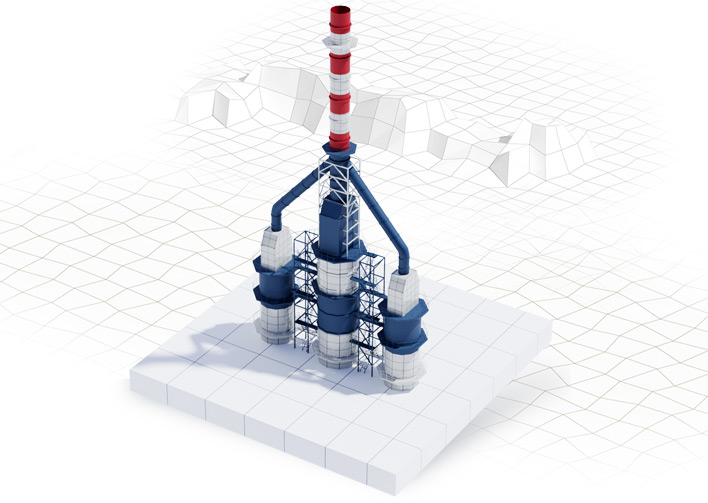TECHNOTECS designs and manufactures the following types of furnaces:
- Atmospheric and vacuum furnaces
- Heat transfer agent heaters
- Hydrotreater furnaces
- Start-up furnaces
- Superheaters
Furnaces are designed depending on the process:
— furnaces where chemical reaction occurs (reaction heaters): steam reforming, delayed coking, visbreaking, thermal cracking;
— heating furnaces: atmospheric-vacuum distillation, furnaces in the lines of gas/condensate stabilization plants, heat transfer agent heating furnaces, associated petroleum gas processing lines.
Type of furnace is determined by the shape of radiation chamber, mutual arrangement of radiation and convection chambers, configuration of radiant coil, type and location of burners.
Types of furnaces:
- Cylindrical, box-shaped
- Single-chamber, multi-chamber
- Furnaces with vertical, horizontal, spiral radiant coil
- With bottom, vault or wall burners
- With burners located on side and end walls, in one or more tiers
- With gas and liquid fuel burners and other types
Depending on the method of heat transfer, configuration and number of combustion chambers, location of burners, as well as number of process streams and type of tube irradiation, tube furnaces are divided into the following types:
VS - Box-shaped furnace, with vertical arrangement of coil pipes, free vertical flare combustion of combined fuel;
GS - Box-shaped furnace with top flue gas outlet, horizontal arrangement of coil pipes, free vertical flaring of combined fuel. Type GS2 – with two radiation chambers;
GN - Box-shaped furnace with top flue gas outlet, horizontal arrangement of coil pipes, volumetric-flat combustion of combined fuel or flat combustion of gas fuel. Type GN2 – with two radiation chambers;
KS - Cylindrical furnace with annular convection chamber, built-in air preheater and vertical pipe coils in radiation and convection chambers, free vertical flaring of fuel;
CS - Cylindrical furnace with near-wall arrangement of coil pipes in one radiation chamber, free vertical flaring of combined fuel;
SS - Cylindrical furnace with cylindrical radiation chamber and separate convection chamber for free vertical flaring of fuel;
PTB - Tubular block furnace for oil treatment units with electrically actuated valves;
PPN - Direct oil heating furnace.
Application
- Oil and gas refining
- Petrochemical industry
Scope of Tubular Furnace
- radiation chamber;
- convection chambers;
- product coil;
- gas collector (transition);
- stack;
- gas ducts, piping of burners, fire-fighting system;
- burners.
Ladders and platforms, exhaust (blast-relief) windows, inspection holes, doors, manholes, instrumentation nozzles and instrumentation equipment are provided for maintenance of furnaces and ensuring their normal operation. If necessary, furnaces can be equipped with steam superheaters, heat recovery system, air heaters and fans.
Principle of operation
Despite wide range of furnace designs, their operating principle is mostly the same. Typically the internal space of the furnace is divided into two parts, called radiant and convection chambers. These chambers contain pipe coils transferring heat through their surfaces.
Radiation heat transfer is the process of radiant heat absorption, and convective heat transfer is heat transfer by washing the surfaces of pipes by flue gases.
In the radiant chamber main amount of heat is transferred by radiation and only a small amount by convection, and in the convection – vice versa.
Fuel combustion products are the primary and main source of heat absorbed in the radiation section of tubular furnaces - 60–80% of the total heat used in the furnace is transferred in the radiation chamber, the rest – in convection section.
Product that needs to be heated by one or more streams enters the pipes of convection coil, passes through the pipes of the radiation chamber screens and, heated to the required temperature, leaves the furnace.


